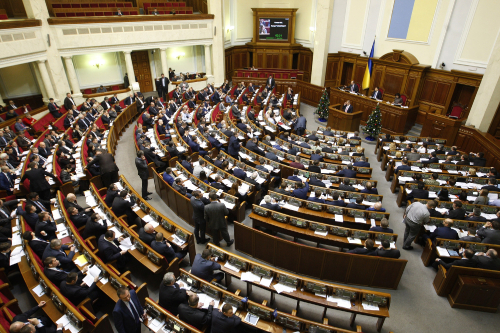|
 |
|
TURNING WEST: Ukraine's parliament voted overwhelmingly to repeal a 2010 bill of nonalignment in Kiev on December 23, 2014 (CFP) |

At a time of civil war, Ukraine has taken a major step in pivoting toward the West. In a move that may intensify the conflict in the country's east, Ukraine's parliament voted with overwhelming approval to repeal a law of "nonalignment" on December 23, 2014.
The nonaligned status, which Ukraine adopted in 2010 under former President Viktor Yanukovych, prevents the state from joining military-political alliances, such as NATO. However, Ukraine broke with Russia after the latter annexed the Crimean Peninsula last March. Now the pro-Russian law ensuring nonalignment has been replaced by a pro-Western bill to pave the way for NATO membership.
The revised bill, which was approved in a vote of 303 to eight, stressed that the nonaligned status did not help safeguard Ukraine's national security nor protect the country from aggression. Speaking after the vote, Ukrainian President Petro Poroshenko said the country would decide whether to join NATO through a referendum.
A realistic choice
Ukraine's move is a clear sign of Poroshenko's plan to join NATO. More importantly, it demonstrates a wider political strategy.
Geographically, Ukraine is sandwiched between two mighty civilizations--Russia to the east and Western Europe to the west. Since the 15th century, the vast Ukrainian territory was the frontline of expansionary wars launched by the Kingdom of Poland-Lithuania, the Empire of Austria-Hungary, tsarist Russia and the Soviet Union. Conquered by various powers, Ukraine repeatedly suffered pains of territorial splits amid short-lived unification.
Historically, Ukraine lacked great leaders who could stop the rule by foreign states. Several attempts to obtain national independence were all put down by strong external forces. In a sense, pursuing relative independence while being under the influence of a mighty power has long been a historical reality for Ukrainians. Now Ukraine wants to loosen the grip of Russia despite sharing close ties in terms of history, culture, politics and economy. In the 19th century, Ukraine's eastern territory was under the sphere of Russian influence. The country eventually joined the Russia-led Soviet Union in 1922 as one of the union's seven initial republics. In the ensuing 70 years, Ukraine achieved its national autonomy and established an integral industrial system--a key component to the country's independence, while resentment of Russia persisted. Many tragic events, such as the great famine in the 1930s, the Soviet Amy's crackdown on pro-Nazi Ukrainian Insurgent Army (UPA) during World War II (WWII) and policies limiting Ukraine's culture and languages, were imprinted in the Ukrainian people's collective memory. Voices of distrust, condemnation and hostility toward Russia have been especially strong in western Ukraine.
As a result, extreme nationalism is resurgent in Ukraine. Far-right organizations propagate their beliefs on a large scale. While promoting the idea of national rejuvenation, extreme nationalists even try to whitewash the UPA's history and underplay the Soviet Union's role as a major force in the anti-Fascist war.
Dropping the nonaligned status is a pragmatic choice for the Ukrainian Government amid the domestic unrest. After the collapse of the Soviet Union, Ukraine became an independent non-nuclear state. The urgent priority to protect national security by other means thus prompted Ukraine's strategic course to join Western Europe, in hopes of staving off economic depression and social unrest. Seeking NATO membership is another important step in guaranteeing its national security.
But in the two decades following the fall of the Soviet Union, the road to the West has been full of twists and turns as Ukraine's foreign policy swings repeatedly under the rule of a pro-Russian or a pro-Western government. Each time Ukraine approaches NATO, Russia expresses its strong disapproval.
Advanced by then President Yanukovych, Ukraine's parliament approved a bill outlining its nonaligned status in 2010, which temporarily suspended the domestic argument as to whether to join NATO.
But Ukraine fell into a state of chaos after Yanukovych was expelled by the pro-Western political party in February 2014. Russia annexed the Crimean Peninsula a month later, triggering military conflicts as the rebels in eastern Ukraine fought to separate from the country. A risk of national secession loomed large. The new Poroshenko administration has since actively sought external support by pursuing NATO membership.
| 